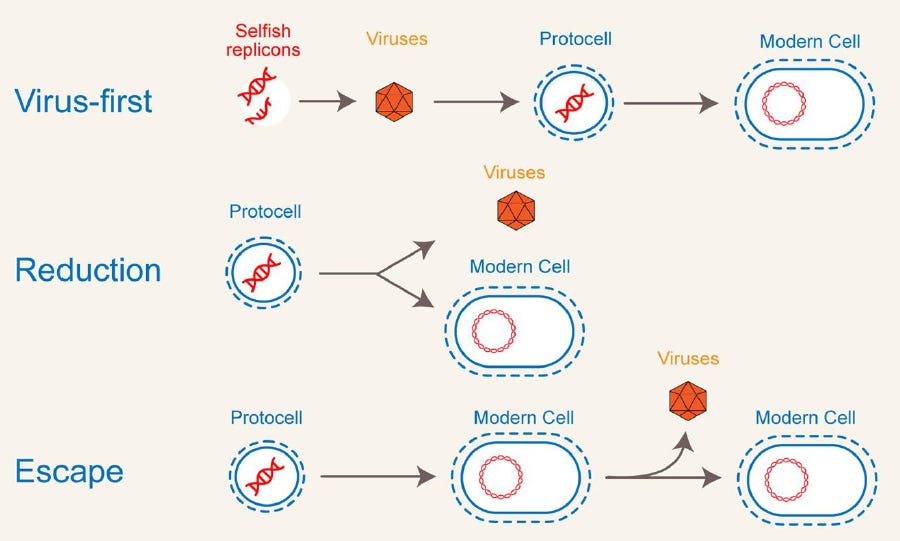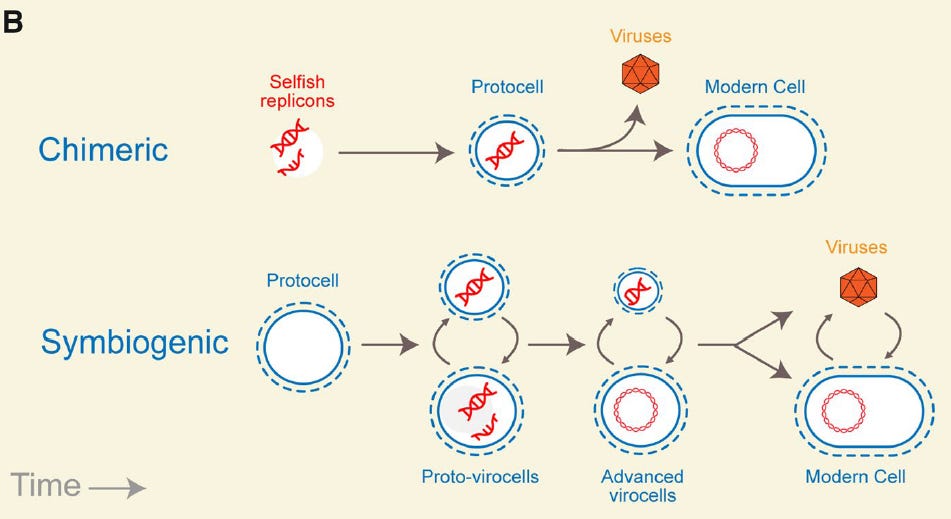The earliest traces of lifeforms (fossilized bacteria, preserved remains of microbial mats) indicate that the life on earth is about three and a half billion years old.
In retrospection the earth itself is about 4.5 billion years old. However, the origin of viruses is a complex and still somewhat mysterious topic in biology, with several hypotheses proposed to explain their emergence. Despite over a century of virological research and recent advancements in evolutionary genomics, there remains ongoing debate about whether viruses are living or nonliving entities.
To answer these questions we must first organize our thoughts on what we call ‘life’ , its specific definitions my vary but the general consensus is that living organisms exhibit several key properties, they grow, reproduce, maintain an internal homeostasis, respond to stimuli, and carry out various metabolic processes all while their populations evolve.
Do viruses fall under these criteria? Sometimes. We all probably realize that viruses have to reproduce in some way especially after the global pandemic. One can become infected with a small number of virions (virus particles) which my have multiple modes of entry into our body take the SARS‑CoV‑2 (Covid-19) for instance, inhaling particles expelled when an infected person coughs leads to another person (in proximity) becoming sick several days later as the viruses replicate within their bodies. Likewise we also all realize that viruses evolve over time. We need to get a flu vaccine every year primarily because the influenza virus changes, or evolves, from one year to the next (Nelson & Holmes, 2007).
What viruses cannot do, however, is to carry out metabolic processes. The primary distinction between viruses and other organisms is their inability to produce ATP. Viruses also lack the machinery required for translation. They are unable to produce proteins on their own from messenger RNA molecules since they lack ribosomes. These restrictions mean that viruses can only reproduce inside of a living host cell. Viruses are therefore obligatory intracellular parasites. They are not living by a strict definition of the term. According to a stringent definition of life, they are nonliving. Although not everyone, necessarily agrees with this conclusion.
Where do Viruses come from?
The canonical frameworks of viral evolution traditionally describe viruses as precursors to cells, simplified forms of cells, or as entities that escaped cellular control. However, the discovery of giant viruses has disrupted these conventional paradigms. Their genetic, proteomic, and structural complexities share semblance to cells, prompting a reconsideration and reclassification of viruses. This question has fascinated both scientists and the public for a long time, but it has proven to be exceptionally challenging to answer. One major hurdle is the unusually high viral diversity (both genetic and morphologic) seen in the hundreds or possibly thousands of existing viral lineages [1,2]. Not a single feature appears to be conserved across the virosphere suggesting that viruses may have originated multiple times in evolution, and possibly via more than one mechanism. The lack of unifying characteristics also suggest that viruses are probably very ancient. Under these assumptions, three classical viewpoints have emerged in the scientific literature in various forms.
The progressive or escape hypothesis proposes that viruses originated from genetic elements that developed the ability to move between cells. The regressive or reduction hypothesis suggests that viruses are remnants of once fully functional cellular organisms. The virus-first hypothesis posits that viruses existed before or coevolved with their current cellular hosts.
Mughal, F., Nasir, A. & Caetano-Anollés, G. The origin and evolution of viruses inferred from fold family structure. Arch Virol 165, 2177–2191 (2020).
None of these models satisfactorily captures or explains the massive diversity of the virosphere, and each has its shortcomings. Consequently, hybrid models that combine elements from the different viewpoints have also emerged. For example the model proposed by Krupovic et al [3]. combines elements from the virus-first and escape models, making it chimeric. The authors categorize virus genes into two genetic modules: one involved in replication and the other in virion structure and assembly [3]. The replication module originated in an 'ancient world' (RNA world) inhabited by primordial genetic elements that existed before cells. This ancient origin explains the vast diversity observed in the replication strategies and genomes of modern-day viral lineages. In contrast, the structural genes responsible for virion formation and assembly were gradually acquired from cells as they appeared in evolution [3]. Single jelly-roll fold, the most common capsid protein fold in RNA viruses, shows structural similarities to several cellular proteins, primarily carbohydrate-binding proteins. While capsids are central to any model of virion origins, capsid-like analogs are rare or absent in cells, and some capsid protein folds are unique to viruses, this does not serve to support this hypothesis.
On the other hand, the 'co-evolutionary' symbiogenic model proposed by Nasir and Caetano-Anollés [4] suggests that viruses reduced from ancient cells with segmented RNA genomes as the communal world of cells was emerging on the planet, giving rise to the ancestors of Archaea, Bacteria, and Eukarya. According to the symbiogenic model, this primordial group devolved into viruses through selective loss while remaining linked to cellular hosts via cycles of cellular internalization. The key difference with previous models lies in the timing of genome origins and the gradual unfolding of replication novelties in cells, rather than before them. In other words, instead of virus-like genetic elements evolving in a pre-cellular world, their genetics co-evolved alongside ancient cells. The symbiogenic model also suggests that RNA viruses were the first to originate in evolution. Later, retro-transcribing and DNA viruses either co-evolved directly from RNA viruses or evolved independently from the viral stem line of descent when RNA-based replication systems were gradually replaced by DNA-based replication counterparts.
Moreover, the model does not constrain ancient viruses to propagate via virion synthesis or other means. Instead, ancient cells produced vesicles that transported genetic cargo within the emerging cellular community, a process referred to as 'vesiduction.' Vesicle-mediated transport, routinely observed in multicellular organisms, interestingly resembles virus exit pathways [5]. Therefore, ancient virions were likely free-floating vesicles that mimicked modern-day virus transmission via virions. More sophisticated virion structures evolved much later, coinciding with the appearance of diversified cellular lineages.
Mughal, F., Nasir, A. & Caetano-Anollés, G. The origin and evolution of viruses inferred from fold family structure. Arch Virol 165, 2177–2191 (2020).
Where and how viruses came to be is not going to be a simple question to answer. One can always convincingly argue that certain viruses, such as the retroviruses, arose through a progressive process, mobile genetic elements becoming infectious agents as they gained the ability to travel between cells. Conversely, it is also quite plausible that large DNA viruses emerged through a regressive process where once-independent entities lost key genes over time and adopted a parasitic replication strategy. Additionally, the notion that viruses contributed to the origin of life opens up intriguing possibilities. It is possible that today's viruses arose multiple times through various mechanisms, or perhaps all viruses originated through a mechanism not yet discovered. Ongoing research in fields like microbiology, genomics, and structural biology may one day eventually provide us the answers to this fundamental question that had plagued us for over a century.
[1] Prangishvili D, Bamford DH, Forterre P et al (2017) The enigmatic archaeal virosphere. Nat Rev Microbiol 15:724–739
[2] Nasir A, Caetano-Anollés G (2017) Identification of capsid/coat related protein folds and their utility for virus classification. Front Microbiol 8:380. https ://doi.org/10.3389/fmicb .2017.00380
[3] Krupovic M, Dolja VV, Koonin EV (2019) Origin of viruses: primordial replicators recruiting capsids from hosts. Nat Rev Microbiol 17:449–458. https ://doi.org/10.1038/s4157 9-019-0205-6
[4] Nasir A, Kim KM, Caetano-Anollés G (2012) Viral evolution: primordial cellular origins and late adaptation to parasitism. Mob Genet Elements 2:247–252. https ://doi.org/10.4161/mge.22797
[5] Meckes DG, Raab-Traub N (2011) Microvesicles and viral infection. J Virol 85:12844–12854. https ://doi.org/10.1128/jvi.05853-11



